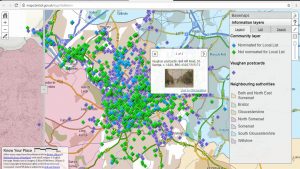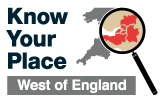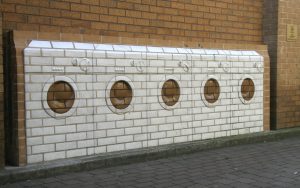Preparing records to share on Know Your Place
In Top Tips this time we turn our attention to growing the Know Your Place map in a different way – by adding to the Community Layer.
Putting your information on the Map
With seven counties now mapped onto Know Your Place – and extra map layers being added soon – its time we start thinking about what other heritage information we can pin onto the map’s Community Layer.
At Project HQ we’re busy working with partners in archives, museums, libraries and heritage centres to map archival records and museum artefacts from the region’s public collections onto Know Your Place.
But Know Your Place is a community resource and is designed for everyone to use and add to on our ‘Community Layer’. The more information we share onto Know Your Place, the richer this shared map of our local heritage will become.

A treasure trove of diamonds indicate the number of records mapped onto KYP Bristol’s Community Layer.
Get Involved
So whatever your interests or expertise, there are many ways in which you can get involved individually. Here are just a few ideas to try:
- Take streetview snaps of your street as it looks today
- Share memories of places you have lived, worked and played in the past
- Map dug-up discoveries from your back garden or attic
- Record a local architectural detail, building or war memorial that means something to you
- Let us in on your family history research
Adding Records in Three Simple Steps
Adding records is easy and anyone can do it. But it does require a little thought and preparation. Follow these three simple steps to get ready:
1.Research
Explore your area on Know Your Place to see what information has already been mapped for your area and how your new information will add to a better understanding of your area. Switch on different Information Layers and see how other people have written their records to get some ideas of what you might like to add.
2.Prepare
Get your material ready and think about what you want to say about it. Know Your Place has a simple form to fill in, so have a think about what information you want to put in each field.
Come up with a simple title for what you are adding – is it a photograph, document, architectural feature or specific story? Write a detailed description about what you are adding – where is it from, what does it represent, how old is it, who made it, what story does it tell?
If you are attaching an image or media file, be sure that you hold the copyright or have permission to share.
If you are adding material for an archive, museum or other collection, you also should think about adding the object’s reference number and Organisation’s name and website address.
3.Locate
Take some time to find the location where you want to add your record. For example, try to pin an old photo on the exact place where it was taken, or the street or building that it depicts. The more precisely you can map your information, the better. Try searching for the address in Know Your Place and compare historic maps from different times to see how this area has changed over time. Most importantly, check and check again until you are happy you are looking at the right place to add your record.
You’re now ready to add your record!
We can’t wait to see what appears on Know Your Place over the coming weeks and months….
Additional help in adding your records can be found on our Other Resources page, or you could try contacting us.


